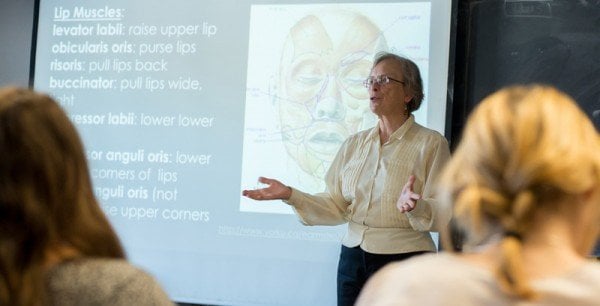A new study indicates that children with Down syndrome who have motor speech deficits have been inadequately diagnosed, which could have a major impact on the interventions used by speech pathologists when treating patients.
Children with Down syndrome who have motor speech disorder characteristics have historically been diagnosed as having childhood dysarthria. Meanwhile, symptoms of childhood apraxia of speech may have been missed based on the assumption that they coud not have both disorders. The study, published in the International Journal of Speech-Language Pathology, provides evidence that children can have both motor speech disorders.
Shelley Velleman, chair of the Department of Communications Sciences and Disorders at the University of Vermont, and her colleagues conducted motor speech assessments on seven children with Down syndrome in comparison with typically developing children. They also analyzed the motor speech and non-speech oral motor skills of all participants using an investigator checklist of characteristics of apraxia, dysarthria as well as other non-specified motor speech disorders.
The results support Velleman’s hypothesis that children with Down syndrome who exhibit symptoms of both disorders can, in fact, have overlapping symptoms, and should be treated for all of them. “Children have been automatically placed in one of those boxes,” Velleman says, “when the reality is that many kids have a combination, so you have to look at all of the symptoms and treat the child accordingly or it’s not going to be very helpful.”
Findings key to determining proper therapy
The finding is especially significant because of the different ways in which speech pathologists work with children who have apraxia compared to those with dysarthria. Therapy for dysarthria, a neuromotor disorder, is largely compensatory because the motor pathways are damaged and cannot be repaired. Consequently, clinicians teach techniques that increase intelligibility or clarity of speech. Conversely, most individuals with apraxia benefit more from therapy focusing on motor planning training as opposed to compensation.
“With dysarthria, kids’ brains know what to do, but they can’t carry it out because the muscles they use to speak have low tone or are weak,” says Velleman. “With apraxia the muscles can do it, but it’s a matter of the brain not being able to communicate with the muscles. So if you took a kid with apraxia and you worked on dysarthria to try to get a nice strong “S” sound, well that’s nice, but they won’t be able to do it when they need to.”
Velleman advises therapists to treat the symptoms they see regardless of the diagnosis. “The most important thing is to figure out the symptoms,” she says. “If they have three symptoms of dysarthria, three of apraxia and three of something else like a phonological disorder, don’t worry about an official diagnosis; go ahead and treat all of the symptoms.”
New test could help with more accurate diagnosis
For those who want a definitive diagnosis, Velleman and her co-authors, Vani Rupela, a speech language pathologist in the Fairfax County, Virginia, public school system, and Mary Andrianopoulos, an associate professor in the Department of Communication Disorders at the University of Massachusetts Amherst and a 1979 UVM alum, developed a test they named the Language-Neutral Assessment of Motor Speech for young children, or LAMS.

Developed specifically for their study, the test allowed the team to conduct the motor speech assessments on the children with Down syndrome, the most commonly occurring chromosomal condition in the United States. The test, which may become available to all speech pathologists in the future, included an observational portion that recorded 50 child utterances during a child-parent conversation, and an imitative task-based section using age-appropriate toys and materials in a play-oriented protocol.
Source: Jon Reidel – University of Vermont
Image Source: The image is credited to Sally McCay.
Original Research: Full open access research for “Motor speech skills in children with Down syndrome: A descriptive study” by Vani Rupela, Shelley L. Velleman and Mary V. Andrianopoulos in International Journal of Speech-Language Pathology. Published online January 11 2016 doi:10.3109/17549507.2015.1112836
Abstract
Motor speech skills in children with Down syndrome: A descriptive study
Purpose: Motor speech characteristics of children with Down syndrome (DS) have historically been viewed as either Childhood Dysarthria (CD) or, more infrequently, as Childhood Apraxia of Speech (CAS). The objective of this study was to investigate motor speech deficits in a systematic manner, considering characteristics from both CAS and CD.
Method: Motor speech assessments were carried out on seven 3;4–8;11-year old children with DS in comparison with younger, typically-developing children using a Language-Neutral Assessment of Motor Speech for young children (LAMS). Additionally, the motor speech and non-speech oral motor skills of all participants were analysed qualitatively using an investigator checklist of characteristics of CAS, CD and Motor Speech Disorder–Not Otherwise Specified (MSD-NOS).
Result: Results indicated that the children with DS exhibited symptoms of CAS, CD and MSD-NOS, with variability within the group and overlapping symptoms of the disorder types. This finding is different from previous assumptions that children with DS have either CD or CAS.
Conclusion: The motor speech disorder accompanying DS is complex. The data provide some preliminary descriptions of motor speech disorders in this population and some tools that clinicians would find useful when assessing motor speech skills of young children with DS.
“Motor speech skills in children with Down syndrome: A descriptive study” by Vani Rupela, Shelley L. Velleman and Mary V. Andrianopoulos in International Journal of Speech-Language Pathology. Published online January 11 2016 doi:10.3109/17549507.2015.1112836






